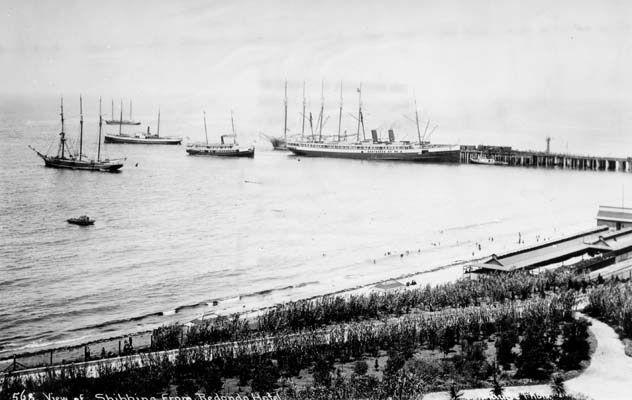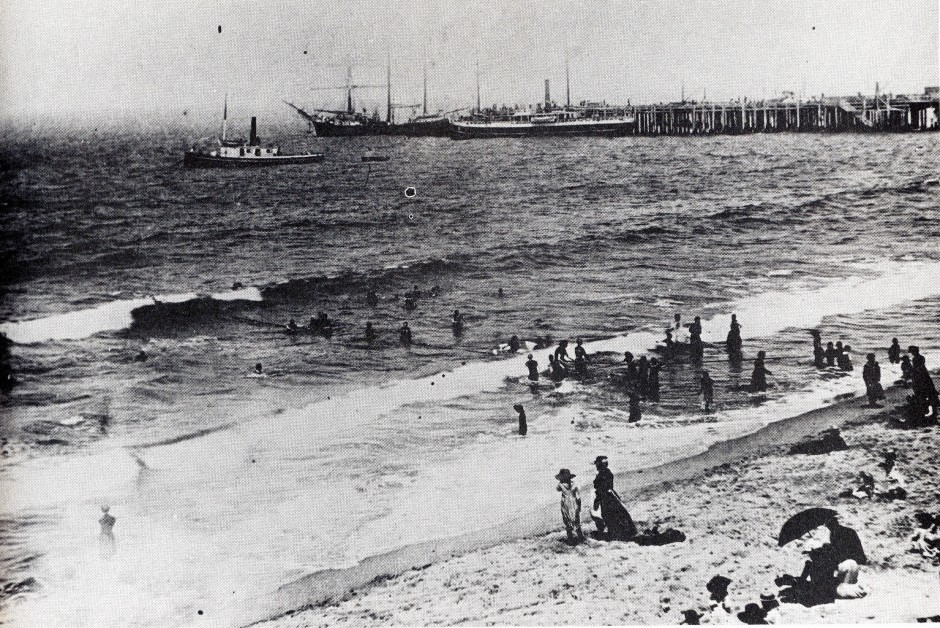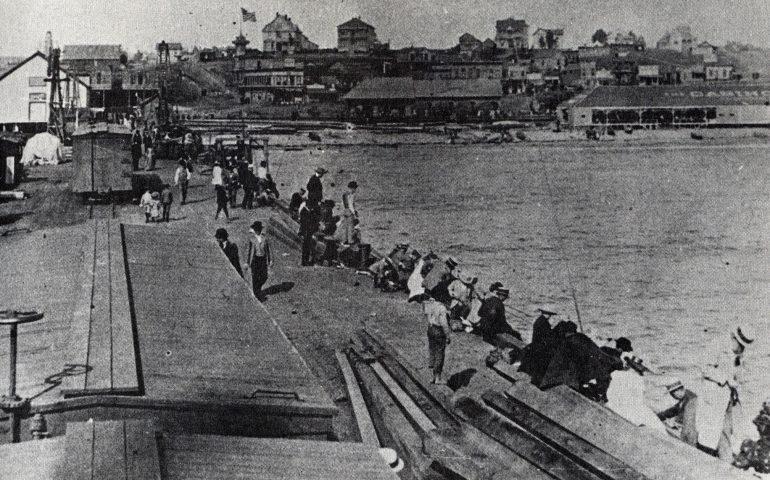By the summer of 1888 people were fishing from the wharf, as seen in the following stories. Assumedly the wharf was the unfinished Wharf No. 1 and it’s clear that people were not afraid to claim fishing rights on a wharf even before its completion—as would also happen to wharves No. 2 and No. 3.
Master A. Currier last Wednesday captured a Jew-fish weighing four hundred pounds, which he brought to this city and sold to one of the markets, and only a day or two ago a stingaree was captured off the wharf which was a monster. It weighed two hundred pounds and was three feet across the back when laid on the ground. His stinger was four inches long. —Los Angeles Herald, June 27, 1888
A Day’s Pleasure

The excursion trains to the coast yesterday were heavier than ever before in the city’s history, this hegira being doubtless caused by the unusually hot weather… Redondo Beach was visited by about 400 pleasure-seekers, most of whom passed the day enjoying the superb fishing from the wharf. —Los Angeles Herald, July 16, 1888
Redondo Beach
The wharf is being pushed at a rapid rate toward deep water, and it will not be very long before deep-sea vessels can land at it safely. —Los Angeles Herald, July 23, 1888
At Redondo—A School of mackerel and Numbers of Other Fish
A great day for fishing was yesterday at Redondo. The big pier was crowded with men and women fishers, to say nothing of the small boy whose name is Legion. A very forest of bamboo rods bristled over the sides of the pier and there was an entanglement of lines, varying in size from the lithe and slender sea grass to the thickness of a cable. The cause of this unusual throng of disciples of Isaac Walton, was the presence of a great school of mackerel in the bay. The water fairly glistened with the silvery sides of the finny denizens of the deep, and those a-fishing did not have to wait long for a bite. The take of mackerel was exceedingly large, and smelt, sole, rock bass and bonito were also taken in abundance. Several fine yellowtail were caught, and the usual complement of shovel-nosed shark were hauled forth from their lair in the briny, much to the fright and discomfort of the more timid anglers…—Los Angeles Herald, August 20, 1888
Apparently the wharf was finished, at least in part, by October of ‘88, when newspapers began to report that steamers could now use the wharf.
Redondo Beach Items
The steamer Eureka, of the Pacific Coast Steamship Company, steamed up to the wharf at Redondo Beach on Friday afternoon, made fast and discharged a quantity of freight for the new waterworks there. —Los Angeles Herald, October 23, 1888
The wharf is complete with the exception of the warehouse and hoisting apparatus which have been ordered built at once. —Los Angeles Herald, December 16, 1888
Things seemed to be happening at a rapid rate but September 1888 also saw the “bust” in the boom or bust speculative real estate market that had enveloped Los Angeles and nearby areas. Prices on lots dropped, many people forfeited the lots they had bought, and most of the syndicates that had been put together to promote different areas pulled back—or ceased operation. It’s not clear the reason—positive, negative or neutral, but soon the Redondo Beach Company would see big changes.
Captains J. C. Ainsworth and R. R. Thompson, Oregon lumber and shipping masters, became the largest stockholders of, and gained control of, the Redondo Beach Company. They would bring additional money into the company as well as additional big ideas.
Redondo Beach
Captain J. C. Ainsworth, of Oakland, and Captain R. R. Thompson, of San Francisco, have recently acquired a controlling interest in Redondo Beach and in Inglewood town sites… It is their intention to build a large wharf at Redondo at which shipping may be done. It is their intention to make this a place for the loading and unloading of the ocean-going vessels of the largest capacity… The wharf is complete with the exception of the warehouse and hoisting apparatus which have been ordered built at once. About five miles of water-works are nearly completed and pipes, etc. will be laid at once. The company proposes to go on with the improvement of the place regardless of what may be done in the way of sales of property, believing that this as well as other interests in Southern California are certain of ultimate success. The presence of such men as the Mesars. Ainsworth and Thompson, the one a resident of Oakland and the other of San Francisco, shows in what esteem this section is held. They are intimately acquainted with the resources of the whole Coast, and when they, the other day, put their money into this property, they acted with eyes wide open, and did so because they feel well assured that there is a great future before Los Angeles, and before all this southern country. —Los Angeles Herald, December 18, 1888
With the wharf complete it was now time to bring the Pacific Coast Steamship Company into the equation
The Redondo Wharf — Particulars Regarding the Steamboat Service
The Herald yesterday morning announced that an arrangement has been made by which the Pacific Steamship Company’s boats are to call at Redondo Beach, and through the courtesy of Mr. W. Parris, the Company’s agent here, it is enabled now to give the full particulars regarding the traffic. From now on the freight streamer Bonita will call at Redondo Beach once a week for freight business only. On and after March 1st the steamers Eureka and Los Angeles, handling both freight and passenger business, will call at Redondo, making a service every four days to and from that point. The steamship company has made this change on account of the increased necessities of this southern territory, and the same order has been put into effect regarding Newport Landing, which has heretofore only had one freight boat (the Newport), touching there every ten days, This change gives Los Angeles three ports of delivery, San Pedro, Redondo and Newport. —Los Angeles Herald, January 31, 1889
On Feb 3 1889 it was announced that the wharf was 900-foot-long and 80 feet wide and had a water depth of 30 feet at low tide (end of wharf) and 18 feet (inshore). It also was diagonally braced underneath with one and one-half-inch iron rods.
It Is Not A Boom — But It Will Develop the Section’s Resources
Once in a while the newshunter in his rounds runs across a man who takes in the significance of these facts, and he finds a little corner of the sun-lit semi-tropics where industry is astir and where enterprise has its coat off and is at work. Such a place is Redondo, and such men are the sagacious, courageous, enterprising men at its head… The Captain is talking: “Yes, it is true we have a wharf at Redondo Beach, and it is true that the Pacific Coast Steamship Company’s vessels are to stop there on their trips up and down the coast. No, it is not true that only the smaller vessels will touch at our wharf. For the current month about one steamer a week will call there, but after March 1st, Redondo will be put on a regular schedule, and all the steamers will call. There is plenty of water, 23 feet, right alongside the wharf at low water. The wharf is 900 feet long, there are two tracks on it, so that vessels can lie alongside and discharge right onto the cars. There is no lightering, no rehandling on the wharf or elsewhere. We are at least two hours nearer than any other shipping point to Los Angeles than any other shipping point on the Coast. Passengers coming from San Francisco may remain here two hours longer than if they were to take the steamer at the old place. —Los Angeles Herald, February 6, 1889
Whoa Nellie! It’s good to be optimistic and sometimes it’s good to toot your horn, but you should never overlook Mother Nature and never assume that a pier is safe from storm and wave (even if it’s in a location supposedly free from danger). All of the press releases and interviews could not mitigate the actions of the sea just over a week later in damaging the wharf and pushing back the scheduled activity.
A Severe Storm — Redondo Pier Damaged
At an early hour yesterday morning a storm commenced to rage west of the Rockies, and was severely felt in Southern California… The most serious damage yet reported is at Redondo Beach, where 150 feet of the fine new wharf, together with the warehouse on the end of it were carried away by the waves which were lashed by the wind into that condition usually expressed as “mountains high.” This instance the work of Boreas will convey a good idea of the severity of the storm, because the wharf was a very strong one, and has only been completed a few months. —Los Angeles Herald, February 16, 1889
What about the March 1st date for Redondo Beach becoming a regular stop for the Pacific Coast Steamship line steamers?
Since the destruction of the Redondo Beach wharf no steamers have stopped there, and although according to schedule both freight and passenger boats were to call after March 1st, it is not thought that they will unless some other arrangements for landing, pending the reconstruction of the pier, can be made. —Los Angeles Herald, February 25, 1889
Redondo Beach Notes
The pier, which had been badly damaged by the storm some time since, has been entirely rebuilt, and now the Redondo Beach Company have as fine a pier as is situated at any point on the Pacific. A large ship was being unloaded at the end of the pier, and seemed to contain quite a cargo of ties… Ships are expected to arrive every day, with lumber for the new hotel, and already the ground has been leveled, and a broad walk has been laid tending to the beach… —Los Angeles Herald, May 20, 1889
Redondo Items
The soon-to-be-completed double-decked iron pier which the Redondo Beach Company will put out means that steamers from all over the known world will land there with perfect safety. —Los Angeles Times, July 15, 1890
Redondo Beach—The smoothest seas of the year are now prevailing at Redondo. Rock cod, halibut and yellowtails are being caught from the pier. Early in the morning long strings of mackerel are pulled out. The balance of the day nothing but larger fish are caught. —Los Angeles Herald, September 4, 1890
Redondo
The noise of the pile driver is heard from early morning until late evening driving piles for the extension and widening of our wharf. It is much needed… —Los Angeles Times, September 6, 1890
The largest yellowtail caught from the wharf this season weighed 32 ½ pounds. A clerk with Coulter & Co., of Los Angeles, now bears the title of “boss fisherman.” —Los Angeles Herald, August 24, 1891
The first school of mackerel of the season gave signal of their vacation from the high seas this week. When the old fisherman sees that sign of fluttering on the still, glossy waters of the bay and knocks the ashes out of his pipe on the heel of his left boot with the air of a man who thoroughly understands himself, and is heard to murmur, “that’s them,” then and not until then it is time to take up your rod and basket and sharpen up your bait knife. Then is the time when the old man, with his trim rod and tackle, basket and pipe, and the small boy with bare feet and knowing smile, are envied because their baskets sound the long roll such as only a mackerel can sound, while the tenderfoot buys bait and gets his line tangled, the small boy still dangles his bare feet over the side of the wharf and smiles and the old man smokes and cuts bait. —Los Angeles Herald, May 7, 1892

Of course the port at Redondo did not go unnoticed, especially by the Santa Fe’s Railroad’s main competitor, the Southern Pacific Railroad. The growth of the Los Angeles basin during the 1880s meant a port was needed. The Southern Pacific favored a port at San Pedro but the port at Redondo was closer to San Francisco, the state’s most important city, and the Redondo wharf began to take business away from the Southern Pacific.
Fighting back, Collis Huntington and the other owners of Southern Pacific announced plans to build their own wharf, one to be located in the north part of Santa Monica, even closer to San Francisco than Redondo.
